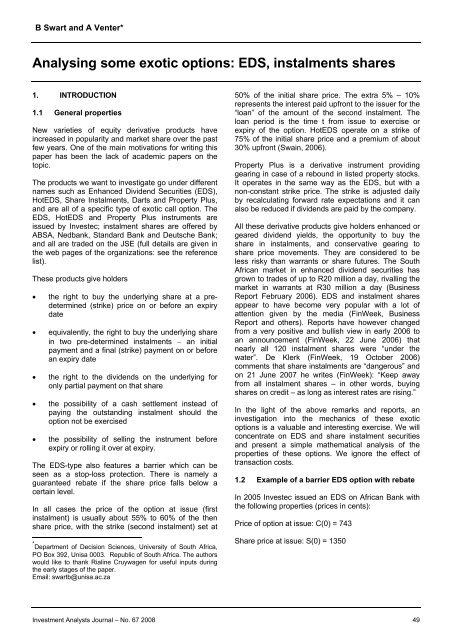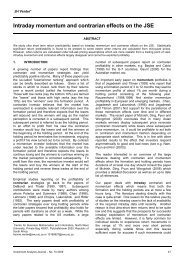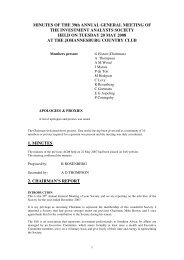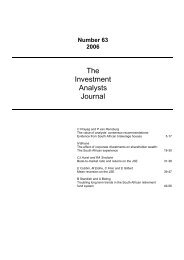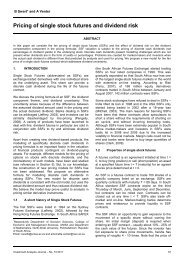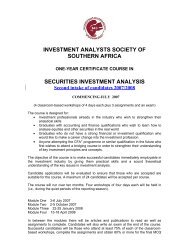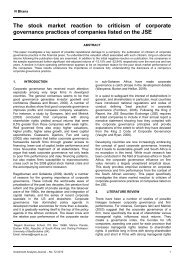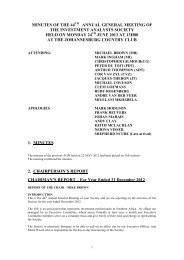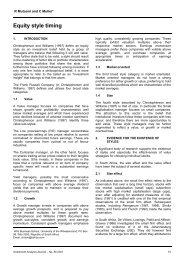Analysing some exotic options - Investment Analysts Journal
Analysing some exotic options - Investment Analysts Journal
Analysing some exotic options - Investment Analysts Journal
Create successful ePaper yourself
Turn your PDF publications into a flip-book with our unique Google optimized e-Paper software.
<strong>Analysing</strong> B Swart <strong>some</strong> and A <strong>exotic</strong> Venter* <strong>options</strong>: EDS, instalment shares<br />
<strong>Analysing</strong> <strong>some</strong> <strong>exotic</strong> <strong>options</strong>: EDS, instalments shares<br />
1. INTRODUCTION *<br />
1.1 General properties<br />
New varieties of equity derivative products have<br />
increased in popularity and market share over the past<br />
few years. One of the main motivations for writing this<br />
paper has been the lack of academic papers on the<br />
topic.<br />
The products we want to investigate go under different<br />
names such as Enhanced Dividend Securities (EDS),<br />
HotEDS, Share Instalments, Darts and Property Plus,<br />
and are all of a specific type of <strong>exotic</strong> call option. The<br />
EDS, HotEDS and Property Plus instruments are<br />
issued by Investec; instalment shares are offered by<br />
ABSA, Nedbank, Standard Bank and Deutsche Bank;<br />
and all are traded on the JSE (full details are given in<br />
the web pages of the organizations: see the reference<br />
list).<br />
These products give holders<br />
• the right to buy the underlying share at a predetermined<br />
(strike) price on or before an expiry<br />
date<br />
• equivalently, the right to buy the underlying share<br />
in two pre-determined instalments − an initial<br />
payment and a final (strike) payment on or before<br />
an expiry date<br />
• the right to the dividends on the underlying for<br />
only partial payment on that share<br />
• the possibility of a cash settlement instead of<br />
paying the outstanding instalment should the<br />
option not be exercised<br />
• the possibility of selling the instrument before<br />
expiry or rolling it over at expiry.<br />
The EDS-type also features a barrier which can be<br />
seen as a stop-loss protection. There is namely a<br />
guaranteed rebate if the share price falls below a<br />
certain level.<br />
In all cases the price of the option at issue (first<br />
instalment) is usually about 55% to 60% of the then<br />
share price, with the strike (second instalment) set at<br />
* Department of Decision Sciences, University of South Africa,<br />
PO Box 392, Unisa 0003. Republic of South Africa. The authors<br />
would like to thank Rialine Cruywagen for useful inputs during<br />
the early stages of the paper.<br />
Email: swartb@unisa.ac.za<br />
50% of the initial share price. The extra 5% – 10%<br />
represents the interest paid upfront to the issuer for the<br />
“loan” of the amount of the second instalment. The<br />
loan period is the time t from issue to exercise or<br />
expiry of the option. HotEDS operate on a strike of<br />
75% of the initial share price and a premium of about<br />
30% upfront (Swain, 2006).<br />
Property Plus is a derivative instrument providing<br />
gearing in case of a rebound in listed property stocks.<br />
It operates in the same way as the EDS, but with a<br />
non-constant strike price. The strike is adjusted daily<br />
by recalculating forward rate expectations and it can<br />
also be reduced if dividends are paid by the company.<br />
All these derivative products give holders enhanced or<br />
geared dividend yields, the opportunity to buy the<br />
share in instalments, and conservative gearing to<br />
share price movements. They are considered to be<br />
less risky than warrants or share futures. The South<br />
African market in enhanced dividend securities has<br />
grown to trades of up to R20 million a day, rivalling the<br />
market in warrants at R30 million a day (Business<br />
Report February 2006). EDS and instalment shares<br />
appear to have become very popular with a lot of<br />
attention given by the media (FinWeek, Business<br />
Report and others). Reports have however changed<br />
from a very positive and bullish view in early 2006 to<br />
an announcement (FinWeek, 22 June 2006) that<br />
nearly all 120 instalment shares were “under the<br />
water”. De Klerk (FinWeek, 19 October 2006)<br />
comments that share instalments are “dangerous” and<br />
on 21 June 2007 he writes (FinWeek): “Keep away<br />
from all instalment shares – in other words, buying<br />
shares on credit – as long as interest rates are rising.”<br />
In the light of the above remarks and reports, an<br />
investigation into the mechanics of these <strong>exotic</strong><br />
<strong>options</strong> is a valuable and interesting exercise. We will<br />
concentrate on EDS and share instalment securities<br />
and present a simple mathematical analysis of the<br />
properties of these <strong>options</strong>. We ignore the effect of<br />
transaction costs.<br />
1.2 Example of a barrier EDS option with rebate<br />
In 2005 Investec issued an EDS on African Bank with<br />
the following properties (prices in cents):<br />
Price of option at issue: C(0) = 743<br />
Share price at issue: S(0) = 1350<br />
<strong>Investment</strong> <strong>Analysts</strong> <strong>Journal</strong> – No. 67 2008 49
<strong>Analysing</strong> <strong>some</strong> <strong>exotic</strong> <strong>options</strong>: EDS, instalment shares<br />
Strike (exercise) price: K = 675<br />
Barrier level: L = 945<br />
Maturity: T =1 year (For our analysis we set time of<br />
issue as t = 0.)<br />
In this example we have K = 0,5 S(0) and<br />
L<br />
=<br />
0,7 S(0).<br />
The option is issued deep-in-the-money with<br />
immediate intrinsic value S(0) – K = 675.<br />
We have the relation<br />
C(0) = 0,5 S(0) + 0,1(0,5 S(0)) (in this example<br />
743 = 0,5(1350) + 0,1(675)), or<br />
C(0) = (S(0) − K) + 0,1(S(0) − K).<br />
The time value at issue is thus only 68. This is typical<br />
of deep-in-the-money <strong>options</strong>.<br />
Seen as an instalment share with instalments<br />
C(0) and K , we can also express the price of the<br />
option as C(0) = 0,5 S(0) + 0,1 K , i.e. the price of<br />
the EDS or first instalment is half the share price plus<br />
interest, paid upfront, of 10% on the outstanding<br />
amount K ( = 0,5 S(0)).<br />
The gearing is almost two: S(0) / C(0) ≈ 1,82. This is<br />
also the dividend gearing (see equation (4a) later on).<br />
The share price S(t) and option value C(t) then evolve<br />
over time t > 0. The gearing is maintained since<br />
deep-in-the-money <strong>options</strong> track the share price on a<br />
nearly 1–1 basis (see Section 3).<br />
If the underlying share price S(t) hits the barrier at<br />
<strong>some</strong> time t =τ, then the EDS terminates and the<br />
holder receives the intrinsic value of the option. In this<br />
case it would be S(τ) – K ≈ L – K = 0,20 S(0) = 270.<br />
There is a loss, limited to 473 cents or 64% of the<br />
premium. But note that holding the share itself would<br />
have meant a loss at t = τ of only 405 cents or a 30%<br />
loss with the investor still owning the share.<br />
If the option (EDS) is exercised at <strong>some</strong> time t, the<br />
holder will pay amount K to receive a share valued at<br />
S(t). At maturity, the option can be exercised, settled in<br />
cash to the value S(T) − K , or rolled over. In the latter<br />
case, the intrinsic value S(T) − K would have to be big<br />
enough to cover the price C*(0)of the new issue of<br />
the EDS on that particular share.<br />
Between t = 0 and time of exercise or termination of<br />
the EDS, the holder receives all dividends (if any).<br />
Possible scenarios at time t, 0 < t ≤ T , are illustrated<br />
in Table 1. We compare the cases of buying and<br />
exercising the option versus holding the share itself.<br />
As the barrier is approached, losses on the option<br />
increase. At the time of the analysis the risk-free rate<br />
was about 9%.<br />
Selling the option instead of exercising is another<br />
possibility that we consider later.<br />
If dividends with time-t value of say 50 cents are<br />
included, the option profits will increase by about 6,7%<br />
and those of the share by about 3,7%.<br />
At t =<br />
T, roll-over would be possible only if<br />
S (T) − K > 0,5 S (T) + 0,1(0,5 S (T)),<br />
assuming that an interest rate of 10% will again apply<br />
to the loan of the new second instalment. Hence rollover<br />
is possible in this case only if S(T) > 1500; in the<br />
case where rising interest rates indicate an interest<br />
rate of say 12% on the new loan we will need<br />
S(T) > 1534. Rising interest rates however can mean<br />
that share prices are slow to increase.<br />
Table 1: Profit or loss when exercising the EDS versus owning share at time t<br />
Share price<br />
(cents) at t<br />
Action taken<br />
% option profit<br />
(S(t) − K − C(0)) / C(0) × 100<br />
% share profit<br />
(S(t) − S(0)) / S(0) × 100<br />
2000 Exercise option 78,3% 48,1%<br />
1800 Exercise option 51,4% 33,3%<br />
1600 Exercise option 25% 18,5%<br />
1500 Exercise option 11% 11%<br />
1450 Exercise option 4,3% 7,4%<br />
1000 Exercise option –56% –26%<br />
945 Accept rebate –64% –30%<br />
50 <strong>Investment</strong> <strong>Analysts</strong> <strong>Journal</strong> – No. 67 2008
<strong>Analysing</strong> <strong>some</strong> <strong>exotic</strong> <strong>options</strong>: EDS, instalment shares<br />
2. GENERAL ANALYSIS<br />
The analysis is based on approximate and illustrative<br />
values, but serves to show the effect that interest<br />
rates, share prices, barriers and so on can have on the<br />
profitability of instalment shares.<br />
In general an EDS can be seen as an American downand-out<br />
call option on a share with price S(t). The<br />
option has a barrier L, strike K and maturity T = 1<br />
year. The option is bought at time t = 0 when the<br />
share price is S(0). The initial option price is C(0).<br />
C(0) can be interpreted as the first instalment and K as<br />
the second instalment for buying the underlying share.<br />
For this analysis we set K = 0,5 S(0). This is a<br />
typical value.<br />
We write<br />
C(0) = 0,5 S(0) + δ, … (1)<br />
where<br />
δ is the amount of interest payable upfront for the<br />
“loan” of amount K. The amount δ can be expressed<br />
as a percentage of K and for this analysis (based on<br />
2005 data) will be approximately 10% of K or 5% of<br />
S(0). Rising interest rate scenarios will mean higher<br />
rates.<br />
As deep-in-the-money <strong>options</strong>, EDSs directly track the<br />
performance of the underlying share: a change in the<br />
share price S(t) is accompanied by a change in <strong>options</strong><br />
price C(t) on a near 1-1 basis. This will be shown in<br />
Section 3.<br />
2.1 The effect of the barrier with rebate<br />
If a barrier is present (see Investec-issued securities),<br />
this is often seen as a feature which limits potential<br />
losses by the holder. When the barrier is hit, the option<br />
knocks out and a rebate is offered. However, as we<br />
will see in equation (2) below, this rebate is always<br />
less than the price paid and there is thus always a loss<br />
when the barrier is hit.<br />
Should S fall even further, the holder is protected<br />
against further losses, but at the same time cannot<br />
take advantage if S rises above L at a later stage.<br />
Knock-out seems to be the worst scenario for the<br />
option holder.<br />
Barrier <strong>options</strong> are usually cheaper than comparable<br />
vanilla <strong>options</strong> because the option may expire<br />
worthless before maturity and before potential<br />
recovery of share prices (Higham, 2004). In our case<br />
there is a rebate which would make the option more<br />
expensive than a barrier without rebate.<br />
A typical value for the barrier level of an EDS is<br />
L = 0,75 S(0).<br />
If the underlying share price S(t) hits the barrier at<br />
<strong>some</strong> time t = τ, then the holder receives the intrinsic<br />
value of the option. The time value of the option is<br />
forfeited.<br />
Approximating S(τ) by L, we have<br />
payoff (intrinsic value) = S( τ) −K<br />
≈ L − K = 0,25 S(0).<br />
The “gain” to the holder is<br />
0,25 S(0) − C(0) … (2)<br />
which is of course a loss, since C(0) > 0,5 S(0).<br />
So, if the share price drops by 25% of its initial value,<br />
the option expires and a rebate is paid. In effect you<br />
will have paid S(0)+ δ to receive the value of the share<br />
at that point, that is L ( = 0,75 S(0)). Your return is<br />
about –55%. Knock-out seems to be the worst<br />
scenario for the option holder. (If the barrier is hit after<br />
dividends have been paid the holder of the option<br />
loses slightly less.)<br />
In the case of an extreme and sustained drop in share<br />
price it is true that the holder is potentially better off<br />
with the barrier option than with an option without<br />
barrier. In the latter case there is a 100% loss at T if<br />
S(T) < K, in the former the loss is about 55% at T if<br />
S(τ) < L. This assumes there is no attempt by the<br />
investor to exercise or sell the option earlier. All-in-all<br />
though, one has to question the advantage of holding<br />
an expensive barrier option with rebate.<br />
The probability of the share price hitting the barrier at<br />
a typical value of L = 0,75 S(0) can be estimated.<br />
Assuming a log-normal distribution for the share price<br />
S(t), an annual expected return of μ and volatility of<br />
return σ, we have (Hull 2002):<br />
⎡<br />
1 2<br />
ln S(t) ~ N + μ− σ σ ⎤<br />
⎣<br />
ln S(0) ( )t; t<br />
2 ⎦<br />
.<br />
The notation X ~ N[m;s] denotes that random variable<br />
X is normally distributed with mean m and standard<br />
deviation s.<br />
The probability of going through the barrier at <strong>some</strong><br />
time t, namely P(S(t) ≤ L), can be calculated:<br />
<strong>Investment</strong> <strong>Analysts</strong> <strong>Journal</strong> – No. 67 2008 51
<strong>Analysing</strong> <strong>some</strong> <strong>exotic</strong> <strong>options</strong>: EDS, instalment shares<br />
( ≤ )<br />
P( lnS(t) lnL )<br />
P S(t) L<br />
= ≤<br />
( 1 2 2<br />
) ( 1 )<br />
⎧⎛lnS(t) ⎡ln S(0) t ⎤⎞ ⎛lnL ⎡ln S(0) t⎤⎞⎫<br />
⎪<br />
− + μ− σ − + μ− σ<br />
⎜ ⎢ 2 ⎥⎟ ⎜ ⎢ 2 ⎥⎟⎪<br />
= P<br />
⎣ ⎦ ⎣ ⎦<br />
⎨⎜ ⎟ < ⎜ ⎟⎬<br />
⎪⎜ σ t<br />
⎟ ⎜ σ t<br />
⎟⎪<br />
⎩⎝ ⎠ ⎝ ⎠⎭<br />
= P( Z (t) ≤ −0,77 ) for illustrative values of μ= 0,1; σ = 0,4; t = 1.<br />
= Φ( −0,77<br />
)<br />
= 0,22<br />
( Φ denotes the cumulative probability for the<br />
standardised normal distribution Z).<br />
Thus in this case we have a 22% probability of going<br />
through the barrier towards the end of the year. For<br />
Φ −0,35 ≈ 0,363.<br />
σ=0,6 , we have ( )<br />
For volatilities of between 40% and 60% we thus see<br />
that the probability of going through the barrier at the<br />
end of the year is roughly between 22% and 36%<br />
respectively.<br />
At t = 0,5 (mid-way through the life of the option) the<br />
probabilities are between 15% and 28% .<br />
For HotEDS, the strike is set at K = 0,75 S(0)and the<br />
barrier is set at about 0,85 S(0). The price of the option<br />
is C(0) = 0,25 S(0) +δ with a typical value for δ of 5%<br />
of S(0) (Swain, 2006). In this case the payoff when the<br />
barrier is hit is, L − K = 0,1 S(0). The loss is about<br />
67%.<br />
2.2 Exercising the option in the absence of a<br />
barrier<br />
If no barrier is present (e.g. ABSA, Nedbank, Standard<br />
Bank issued <strong>options</strong>), the option can be exercised at<br />
any time up to T = 1. If there is no barrier, it is never<br />
optimal to exercise this type of option early. If however<br />
S(T) < K the option expires worthless. Your loss is then<br />
100% and the option cannot be rolled over.<br />
Suppose the option is exercised at time t*, and the<br />
shares received in return for payment K.<br />
The payoff in this case is:<br />
S(t*) − K, … (3)<br />
and the gain (profit/loss) to the holder is:<br />
S(t*) - K - C(0) ≈ S(t*) - S(0) - δ.<br />
From this it follows that a profit is made by buying the<br />
share in instalments only if at <strong>some</strong> time t* we have<br />
S t* > S 0 +δ,<br />
( ) ( )<br />
that is, only if<br />
S( t* ) > S( 0)[ 1+<br />
0,05 ]. (Assuming δ=0,05 S(0).)<br />
This means a 5% increase in share price is needed for<br />
a profit. The percentage gain, defined as [ S(t*) – K –<br />
C(0)] / C(0), will then be about<br />
( ) ( )<br />
1, 81 ⎡⎣<br />
S t * /S 0 ⎤− ⎦ 1, 91.<br />
Compare this with the case of owning the share where<br />
a profit is made if S(t*) > S(0) and the percentage<br />
profit is [S(t*) / S(0)] - 1.<br />
The return on owning the EDS is larger than that of<br />
owning the share if<br />
S(t*) > 1,1235 S(0) .<br />
This means a 12,35% increase in share price is<br />
needed for the instalment option to become more<br />
profitable than holding the share itself. However,<br />
buying the option does require a smaller outlay than<br />
buying the share.<br />
Irrespective of when you exercise the option you will<br />
have paid S(0) + δ for the share, ignoring time value of<br />
money. It will be better to exercise after you have<br />
received dividends. As with American <strong>options</strong> on<br />
shares with no dividends, early exercise does not<br />
seem to be advisable.<br />
If the option ends in the money and is not exercised, a<br />
cash settlement of S(T) – K is made.<br />
Note 1: S(T) actually refers to the 2-day simple<br />
average of the daily volume weighted average price.<br />
We shall simply denote all share prices by<br />
S(t), 0 ≤ t ≤ T.<br />
Note 2: If there is in fact a barrier in place early<br />
exercise may be advisable when the share price is<br />
heading for the barrier. The option is still deep-in-themoney<br />
at this stage and may be worth exercising.<br />
2.3 Selling the option instead of exercising<br />
If the object is to speculate and not to acquire the<br />
share, it may be better to sell the option before<br />
maturity. The option can be sold at any time with the<br />
market maker providing a bid/offer spread. The<br />
theoretical (fair) price of the option will be discussed in<br />
Section 3. Transaction costs and the size of the market<br />
maker’s spread will determine the profitability of selling<br />
the option.<br />
52 <strong>Investment</strong> <strong>Analysts</strong> <strong>Journal</strong> – No. 67 2008
<strong>Analysing</strong> <strong>some</strong> <strong>exotic</strong> <strong>options</strong>: EDS, instalment shares<br />
2.4 Dividend gearing and price gearing<br />
Dividends: The holder of the option receives the<br />
dividends on the underlying share.<br />
This is a fairly special feature because normal vanilla<br />
<strong>options</strong> do not entitle the holder to dividends. Such<br />
vanilla <strong>options</strong> on shares with dividends are less<br />
expensive than <strong>options</strong> on shares without dividends<br />
(Higham, 2004). This is because for shares, without<br />
dividends, there is no drop in share price on exdividend<br />
dates with a resulting drop in option value. In<br />
the case of the EDS the property of receiving the<br />
dividends should now make the option slightly more<br />
expensive than the vanilla option on shares with<br />
dividends.<br />
Since <strong>options</strong> are cheaper than the underlying share<br />
itself, the EDS option offers geared dividend yields<br />
with respect to the share. If the expected annual<br />
dividend amount is denoted by d, the dividend yields<br />
are d/C(0) and d/S(0) respectively so that the dividend<br />
gearing is:<br />
divg = { d / C(0) }/ { d / S(0) } = S(0) / C(0) … (4a)<br />
Since C(0) = 0,5 S(0) + δ; the dividend gearing can be<br />
expressed as<br />
( )<br />
divg = 2 −⎡⎣<br />
2 δ / 0,5 S(0) +δ ⎤⎦<br />
. … (4b)<br />
This is just less than 2, depending on the interest δ you<br />
are required to pay. As δ increases, the divg<br />
decreases. For divg to approach 2 the interest will<br />
have to approach zero.<br />
Equation (4b) shows the relationship between the<br />
dividend gearing and interest set by the writing<br />
company. For a dividend gearing of 1,82 we find<br />
δ = 0,05 S(0) = 0,10[ S(0)/2 ].<br />
This implies an interest rate of 10% on the loan<br />
amount. If the loan interest is 20% the gearing drops to<br />
1,67. (The HotEDS has a higher dividend gearing:<br />
about 3,3.)<br />
Price gearing for EDS: The dividend gearing is also the<br />
gearing between prices S and C. In fact, the the<br />
gearing, defined as the ratio of<br />
[ C(t) − C(0) ] / C(0) to [ S(t) − ]<br />
to ΔS /S(0); simplifies to<br />
S(0)/C(0)[ΔC/ΔS].<br />
S(0) / S(0), or ΔC /C(0)<br />
Since [ΔC/ΔS] relates to the delta of the option and we<br />
see later that this is approximately 1, the gearing<br />
remains close to S(0)/C(0). This is just the dividend<br />
gearing divg as shown in the equation (4a). We know<br />
that this is just less than 2, typically 1,82.<br />
2.5 Borrowing from the issuer versus borrowing<br />
from the bank<br />
Assume we have the amount C(0). Let us write the<br />
interest amount δ paid to the writer of the option as f K<br />
or f S(0)/2 where f represents a fixed rate (decimal),<br />
irrespective of the loan period.<br />
Thus C0 ( ) = 0,5 S0 ( )[ 1+<br />
f. ]<br />
If you can exercise the option at maturity (1 year), you<br />
pay the amount K and own the share. The future value<br />
of your payments at maturity is<br />
[ d ]<br />
[ ][ ] ( )<br />
FV = C(0) 1+ r + K<br />
= 0,5 S(0) 1+ f 1+ r + 0,5 S 0<br />
where<br />
r d is the annual discount rate.<br />
This can be written:<br />
( ) ( )[ ]<br />
d<br />
FV = S 0 + 0,5 S 0 f + r + fr … (5)<br />
d<br />
Alternatively, assuming you have C(0), the amount K<br />
– δ can be borrowed from a bank at annual rate r b<br />
(n.a.c.a.) and the share bought at time t = 0. Writing<br />
K −δ= 0,5 S(0) [ 1−f ] , the future value, in this case,<br />
of payments at 1 year is:<br />
( )[ ][ d] [ ][ b]<br />
( ) ( ) ⎡ ( ) ⎤<br />
FV = 0,5 S 0 1+ f 1+ r + 0,5 S(0) 1− f 1+<br />
r<br />
= S 0 + 0,5 S 0 ⎣rd + rb + rd −rb<br />
f ⎦<br />
d<br />
… (6)<br />
The two transactions are equivalent in terms of<br />
equations (5) and (6) if and only if<br />
f + r d + fr d = r d + r b + (r d – r b )f.<br />
This means we should have f = r b / (1 + r b ). For the<br />
instalment option to be advantageous, we need:<br />
( )<br />
f + r + fr < r + r + r −r f<br />
i.e.<br />
d d d b d b<br />
f < r /( 1+<br />
r ) or > ( − )<br />
b<br />
b<br />
r f / 1 f . …(7)<br />
b<br />
With typical f = 10%, paying in instalments looks<br />
advantageous only if we exercise close to maturity and<br />
r > 11,11%.<br />
b<br />
<strong>Investment</strong> <strong>Analysts</strong> <strong>Journal</strong> – No. 67 2008 53
<strong>Analysing</strong> <strong>some</strong> <strong>exotic</strong> <strong>options</strong>: EDS, instalment shares<br />
If however we exercise the option sooner, say at t =<br />
0,5 and for f = 10%, paying in instalments looks<br />
2<br />
advantageous only if r b > f (2 - f) / (1- f) i.e. r b ><br />
23%!<br />
3. BLACK-SCHOLES ANALYSIS<br />
3.1 The price of the option and the greeks<br />
Pricing formulae: From Black-Scholes (Hull, 2002) we<br />
have that the fair price (at t < τ) of a vanilla (no barrier)<br />
T- maturity European call option on a non-dividend<br />
paying share, is:<br />
−rT ( −t<br />
C(t) = S(t)N(d ) − Ke<br />
)<br />
N d … (8)<br />
where<br />
( )<br />
1 2<br />
r is the discount rate for continuous compounding. The<br />
formulae for d 1 and d 2 can be found in (Hull, 2002).<br />
In our case N(d 1) and N(d 2 ) are approximately 1 ( d 1<br />
and d 2 are larger than 3 for deep-in-the-money<br />
<strong>options</strong>), we can use the approximate pricing formula:<br />
−r(T−t)<br />
C(t) = S(t) −Ke … (9)<br />
For a deep-in-the-money option on a share paying<br />
dividends with present value D,<br />
[ ]<br />
− −<br />
r(T t)<br />
C(t) = S(t) −D −Ke … (10)<br />
This follows from (9). (See also Chriss, 1997).<br />
Since with an EDS we actually receive the dividend,<br />
we add D back again and regain the approximate<br />
Black-Scholes pricing formula (9).<br />
An EDS is usually American, but since it is never<br />
optimal to exercise an American call option (nodividend)<br />
early, the pricing formula and analysis of the<br />
EDS is approximately that of the European call.<br />
From (9) the initial theoretical price of the EDS without<br />
barrier according to Black-Scholes pricing should<br />
therefore be<br />
−r<br />
C(0) = S(0) − Ke (T = 1 and t = 0). … (11)<br />
Comparing with C(0) = 0,5 S(0) + δ<br />
this means δ should be approximately<br />
⎡<br />
−r⎤ ⎡<br />
−r<br />
⎤<br />
δ=<br />
⎣<br />
0,5 S(0) − Ke<br />
⎦<br />
= 0,5 S(0)<br />
⎣<br />
1−e ⎦<br />
. … (12)<br />
Formula (12) could be used to compare the interest δ<br />
demanded by the writer, to that predicted by the Black-<br />
Scholes price for given rate r.<br />
For example, if the holder paid δ = 0,05 S(0), this<br />
implies a discount rate of r = 0,1054.<br />
If the option has a barrier L, the holder should pay less<br />
than the price given by equation (9), but for an EDS<br />
there is, at knockout, a rebate equal to the intrinsic<br />
value of the option. Since the time value is relatively<br />
small we argue that the fair price of this option should<br />
then be close to that given in (9) again.<br />
We also have (Chriss, 1997, equation (4.5.1)) the<br />
following useful approximate relation for deep-in-themoney-<strong>options</strong>:<br />
rt<br />
[ ]<br />
C(t) = S(t) − e S(0) −C(0) . … (13)<br />
= S(t) – e rt K + e rt δ<br />
= S(t) – 0,9e rt K for δ = 0,10K.<br />
Exact pricing formulae for barrier <strong>options</strong> are quite<br />
complicated (Björk, 2004) and we will not go into<br />
further details. However, Table 2 compares actual<br />
option prices to those calculated by the approximate<br />
formula (9) and shows that the approximations are<br />
quite adequate for useful analysis.<br />
Delta, vega and time value:<br />
From (9) it is clear that the delta (∆ = ∂C/∂S) is 1. (At<br />
barrier L we can get ∆ >1 for a short period of time.)<br />
This is a consequence of the option always being<br />
deep-in-the-money. The option directly tracks the<br />
performance of the share – we have conservative<br />
gearing to share price movement.<br />
For<br />
−rt<br />
−rt<br />
Δ= 1, C(0) − e C(t) = S(0) −e S(t).<br />
This is approximate. See (Chriss, 1997) equation<br />
(4.5.1). We can write this as<br />
rt<br />
[ ]<br />
C(t) = S(t) − e S(0) −C(0) . … (14)<br />
The vega of the option is ν = ∂C/∂σ where σ is the<br />
volatility of the underlying share.<br />
This is close to zero:<br />
2<br />
( 1) ( ) ( 1 )<br />
ν= N' d = 1/ 2 π exp −d ≈0, because d 1 is<br />
large.<br />
The option is therefore vol-insensitive: changes in the<br />
value of σ do not really affect the value of the option.<br />
54 <strong>Investment</strong> <strong>Analysts</strong> <strong>Journal</strong> – No. 67 2008
<strong>Analysing</strong> <strong>some</strong> <strong>exotic</strong> <strong>options</strong>: EDS, instalment shares<br />
3.2 Selling the option instead of exercising it<br />
In this section we compare the results when the option<br />
is sold before the expiry date, with the results of selling<br />
the underlying share.<br />
In Table 3 we summarise the actual data (obtain from<br />
Sharenet) of a barrier EDS (a European call with initial<br />
underlying share price 1350 and initial option price<br />
743) in May 2005. The market was bullish and either<br />
selling the option or selling the share before the<br />
exercise date was profitable, with the option in the<br />
advanced position.<br />
Table 4 shows the data in June 2007 of the barrier<br />
EDS with the same underlying share. The initial option<br />
price was 1874. In this case the market was<br />
decreasing and both the option and the share lost<br />
money, with the share in the better position.<br />
Table 2: Percentage error in option pricing using approximation (9) with r = 0,0915<br />
Share: S(t) EDS option price Black Scholes approximation % Error<br />
3050 1549 1505 2,8%<br />
3128 1617 1584 2,0%<br />
3130 1630 1587 2,6%<br />
3130 1649 1587 3,7%<br />
3185 1702 1642 3,5%<br />
3212 1778 1670 6,0%<br />
3280 1791 1738 2,9%<br />
3260 1695 1719 -1,4%<br />
3235 1717 1694 1,3%<br />
3060 1563 1519 2,8%<br />
Table 3: Profit: Selling option versus share (2005)<br />
Share: S(t) EDS option: C(t) Selling option<br />
Selling share<br />
% Profit<br />
% Profit<br />
(C(t) - C(0)) / C(0) × 100 (S(t) - S(0)) / S(0) × 100<br />
1720 1083 46% 27%<br />
1670 1048 41% 24%<br />
1655 1018 37% 23%<br />
1625 1021 37% 20%<br />
1650 1021 37% 22%<br />
1620 977 31% 20%<br />
1590 987 33% 18%<br />
1630 993 34% 21%<br />
Table 4: Profit: Selling option versus share (2007)<br />
Share: S(t) EDS option: C(t) Selling option<br />
% Profit<br />
(C(t) - C(0)) / C(0) × 100<br />
Selling Share<br />
% Profit<br />
(S(t) - S(0)) / S(0) × 100<br />
3050 1549 -17% -9%<br />
3128 1617 -14% -7%<br />
3130 1630 -13% -7%<br />
3130 1649 -12% -7%<br />
3185 1702 -9% -5%<br />
3212 1778 -5% -4%<br />
3280 1791 -4% -2%<br />
3260 1695 -9% -2%<br />
3235 1717 -8% -3%<br />
<strong>Investment</strong> <strong>Analysts</strong> <strong>Journal</strong> – No. 67 2008 55
<strong>Analysing</strong> <strong>some</strong> <strong>exotic</strong> <strong>options</strong>: EDS, instalment shares<br />
4. SUMMARY<br />
Exotic <strong>options</strong> make the pool of available financial<br />
instruments bigger and may have many attractive<br />
features. The aim of this paper has been to give <strong>some</strong><br />
ideas on the basic analysis that can be done to provide<br />
insight into the value of EDS or instalment <strong>options</strong>.<br />
Even a simple analysis shows that there are many<br />
factors to consider when buying such an option. Is the<br />
feature of limiting loss with a barrier attractive? What<br />
does the interest paid for the instalment feature<br />
amount to and how does it relate to other interest<br />
rates? Does the investor aim to eventually own the<br />
share, or take a view on a rising share price? Should<br />
the option be exercised early or should it be sold?<br />
http://www.nedbankgroup.co.za/content/press/press_s<br />
hareinstal.asp<br />
http://www.sharenet.co.za/<br />
http://www.standardbank.co.za/SBIC/Frontdoor_02_01<br />
/0,2354,10293765_10297792_0,00.html<br />
http://www.asx.com.au/investor/warrants/tools/library/d<br />
iversification_using_instalments.htm<br />
http://www.theage.com.au/news/annettesampson/how-the-instalmentswork/2006/10/09/1160246069829.html<br />
REFERENCES<br />
Björk, T. 2004. Arbitrage theory in continuous time.<br />
Oxford Finance, Oxford.<br />
Business Report. February 2006.<br />
Chriss NA. 1997. Black-Scholes and beyond. Irwin<br />
Professional Publishing.<br />
De Klerk V. 2006. FINWEEK, 19 October 2006;<br />
FINWEEK 21 June 2007.<br />
Higham DJ. 2004. An introduction to financial option<br />
valuation. University Press, Cambridge.<br />
Hull JC. 2002. Options, futures, and other derivatives,<br />
5 th ed. . Prentice-Hall, New Jersey.<br />
Swain, R. 2006. FINWEEK, 9 November 2006.<br />
Online:<br />
http://www.absa.co.za/absacoza/<br />
http://business.iafrica.com/news/915190.htm<br />
http://www.fin24.co.za/articles/shares/display_article.a<br />
spx?Nav=tr&lvl2=share&ArticleID=1518-<br />
1789_1889673<br />
http://www.investec.com/SouthAfrica/TreasuryandSpe<br />
cialisedFinance/Warrants/HotEDS/<br />
http://www.investec.com/SouthAfrica/TreasuryandSpe<br />
cialisedFinance/Warrants/EnhancedDividendSecurities<br />
/Overview/<br />
http://www.investec.com/SouthAfrica/TreasuryandSpe<br />
cialisedFinance/Warrants/PropertyWarrants/Overview/<br />
http://www.insurancegateway.co.za/investment/module<br />
s/news/?pagename=view.php&newsid=180<br />
56 <strong>Investment</strong> <strong>Analysts</strong> <strong>Journal</strong> – No. 67 2008


